Beauceron is a shepherd dog from the French Middle Ages, which has survived to this day without undergoing almost any changes
Beauceron is an indigenous breed, a direct descendant of the wolf. Initially an irreplaceable herding dog, today it is considered to be a first-class watchdog and a full-fledged member of the family, earning the absolute trust of man. Beauceron embodies the best traits of the canine family: strength, endurance, endless loyalty, companionship, and a willingness to protect those they love.
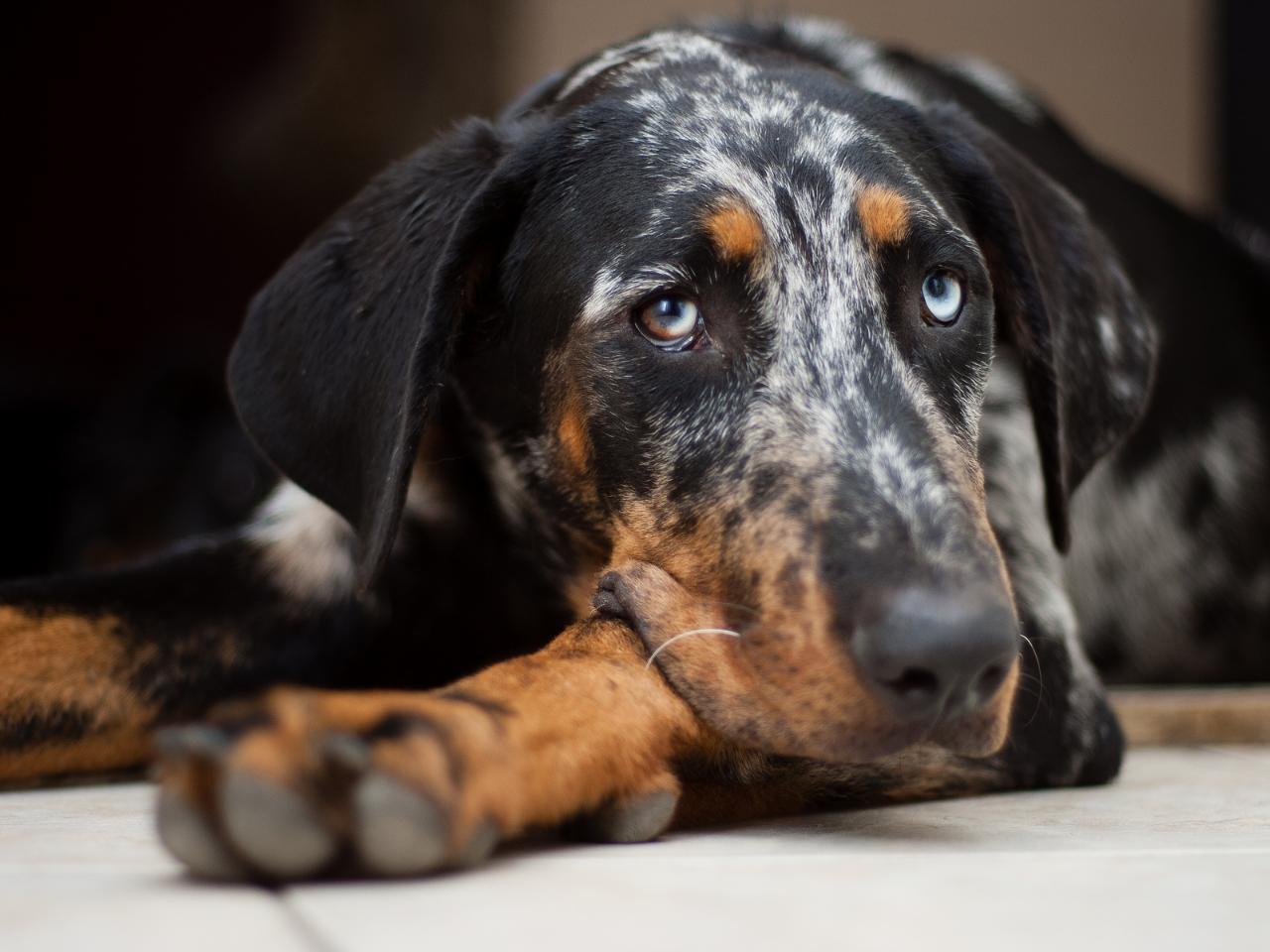
If we talk about the origin of the Beauceron breed, two main hypotheses have been put forward today. According to one of them, the ancestor of the French smooth-haired shepherd dog was a fossil peat dog, the remains of which were found in the Jura mountain range. According to another, the ancestor of Beauceron was a wolf. This version is supported by the great similarity of animals, not only in external appearance but also at the intracellular level. Only geneticists can dot the “and”, but at the moment this problem is not being investigated.
The following is known for sure: the Beauceron breed was formed on the territory of modern France practically without any outside influence. Evolutionary development led to the emergence of a fairly large, very powerful, and hardy dog, which was successfully used in hunting large games.
Over time, the development of agriculture, especially grazing, led to massive deforestation and a significant decrease in the number of hunting objects – bears, wild boars, and deer. The man had an urgent need for herding dogs, and at first, the priority task of such animals was to protect flocks from wolves and even robbers.
The first documentary information about the French Shepherd can be found in a manuscript that dates back to 1578. Much later, in 1809, one of the Catholic abbots wrote a treatise “Working in Agriculture”, where he detailed the question of the correct use of dogs for grazing sheep. The author described two varieties of dogs: the long-haired shepherd dog Brie and the much more powerful guard dog, which can cope with the wolf alone.
Half a century later, in 1863, a dog show was held in Paris, where the French beacon was first presented to the public. However, the breed received official recognition later, in 1896. A commission of respected experts at its meeting approved the first standards for two varieties of the French Shepherd – Berger de Brie (long-haired) and Berger de Beauce (smooth-haired). The name “Beauceron” was given to the French region of Bose. A year later, under the auspices of the French Ministry of Agriculture, the first kennel club of this breed was created. The official club, which dealt directly with the Beauceron, appeared in 1911. It exists to this day and strictly controls the breeding of the breed in France.
Berger de Beauce is very popular in their country but much less known outside its borders. Experts say that this is for the best. None of the “outsiders” had a hand in breeding work, which has allowed to fully preserve all the working qualities of the dogs to this day.
Today, the Beauceron in France is an excellent service dog, which is successfully used both in the army and in police work.
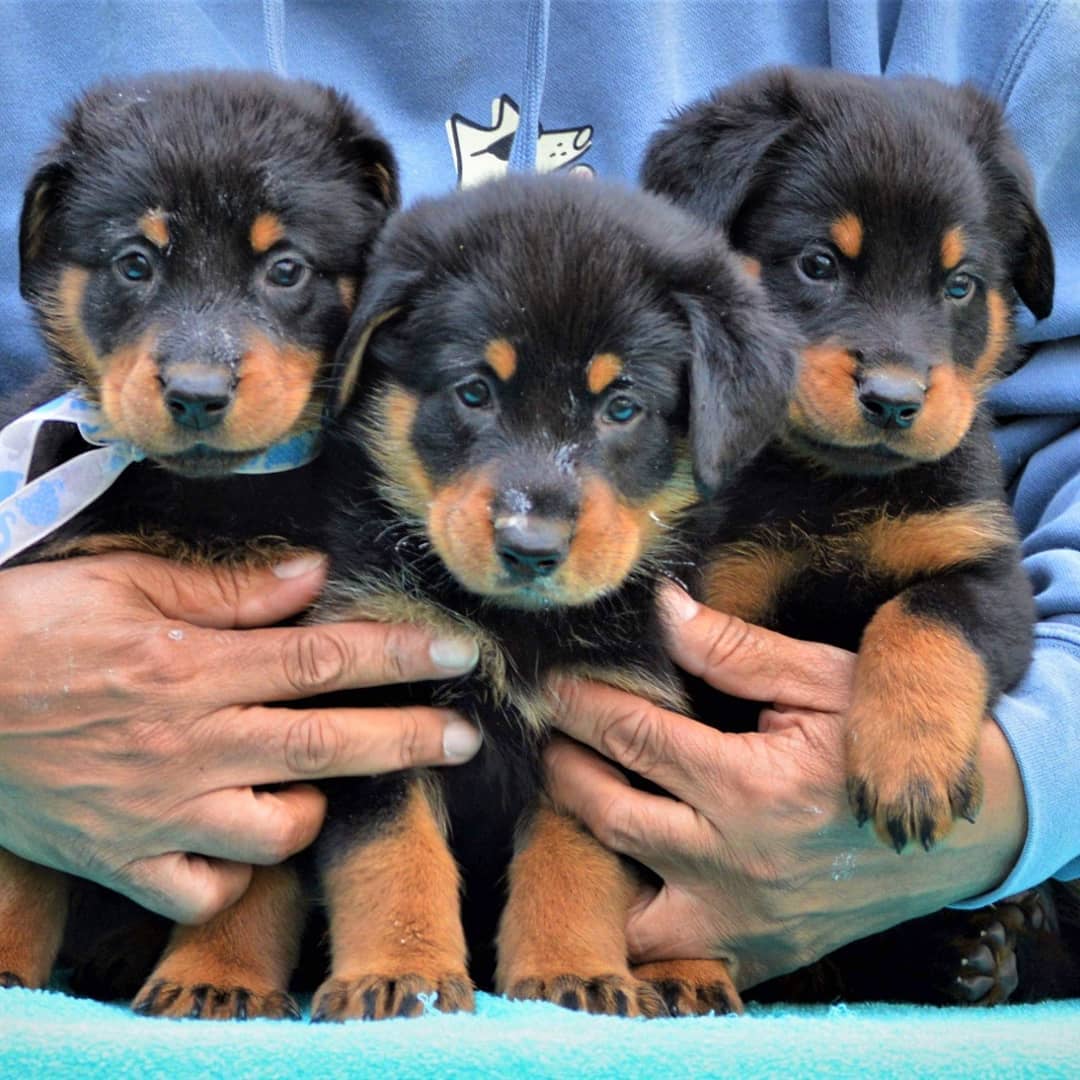
Beauceron is a large dog with a powerful muscular build, but in no way looking heavy. Quite often, the Beauceron is confused with the Doberman or Rottweiler, or with the mestizo of these breeds with shepherds.
The growth of females ranges from 61 to 68 cm, males – from 65 to 70 cm. Bodyweight ranges from 40 to 50 kg, depending on the gender of the animal.
The head is proportional to the body, the skull is rounded and embossed. The stop is soft, smooth. The frontal groove is traced, the occipital protuberance is clearly expressed. The size of the skull and the length of the muzzle is proportional. The muzzle is slightly elongated but neither sharp nor narrow. Scissor bite.
The nose is always black, the lobe is well developed.
The eyes are deep-set and rounded. The color is dark, heterochromia is possible in harlequins. Beauceron always has a clear, calm, and benevolent look.
The ears are set high, if not cropped, they can be drooping or semi-erect, not pressed to the cheeks, not long (no more than ½ the length of the skull). Docked – stand straight, slightly turned forward, but without inclination either to the center or apart.
The neck is muscular, long, blending harmoniously into the withers.
Beauceron’s body is athletic and well-muscled. Not long or short. The chest is well developed and high. The back is straight, the croup is slightly sloping. The loin is wide.
The tail is long, saber-shaped.
The forelimbs are muscular and straight. The hind ones are strong. The popliteal cavity is low. The presence of two dewclaws is required.
The feet are well arched, rounded, with an elastic sole. The nails are always black.
Beauceron’s coat on the head is smooth, short throughout the body (no more than 3-4 cm), coarse, and tight-fitting. Longer fringed on the buttocks and underside of the tail. The undercoat is thick, fluffy, mouse-colored, should not be visible through the guard hair.
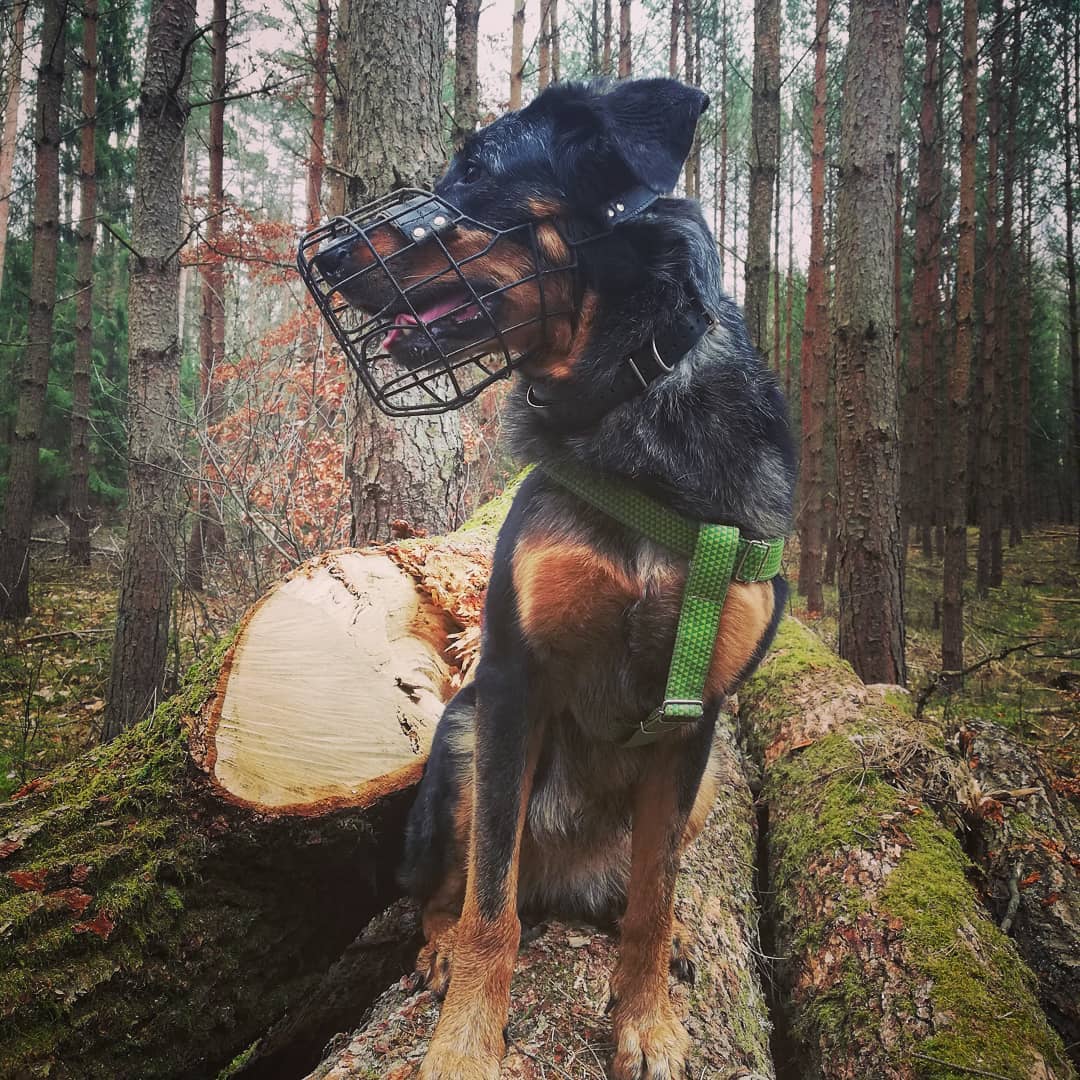
There are two traditional color options for the Beauceron breed.
Black and tan. Black – thick and rich, tan – in the color of squirrel fur. Location of red markings: above the eyes; on the sides of the muzzle descending towards the cheeks, do not reach the ear; on the chest (better if there are two marks); on the lower part of the neck; under the tail; on the limbs, gradually fading away closer to the top, from the outside, the legs rise by about ⅓ of the length, on the inside, slightly higher.
Harlequin. The coat is black-gray with an even distribution of both colors or with some predominance of black; a small white spot is allowed on the chest. The tan is distributed in the same way as in the case of black and tan. This variant is more highly valued due to its rarity.
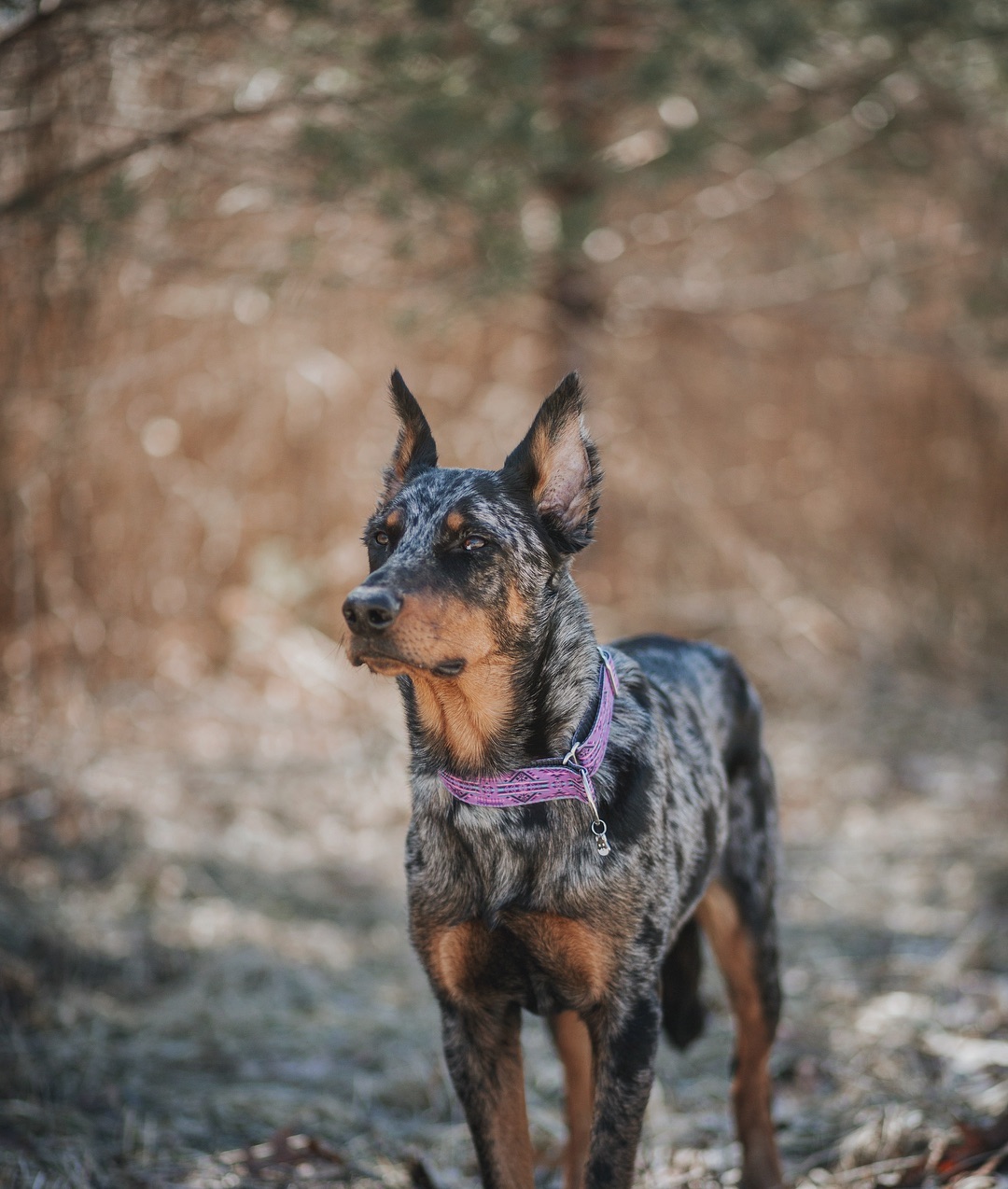
Any deviations from the standard are considered deficiencies, the severity of which is determined on a case-by-case basis.
The grounds for disqualification of a Beauceron at the show are:
- aggressiveness or, conversely, fearfulness of the dog;
- growth abnormalities and lightweight bones;
- light or multi-colored eyes (if the color is not harlequin);
- not black nose;
- bite defects;
- lack of dewclaws on hind legs;
- ears that are erect if they are not cropped;
- shortened tail;
- difference from the standards for the color and structure of the coat (completely gray head, no tan, shaggy; in harlequins – the predominance of gray).
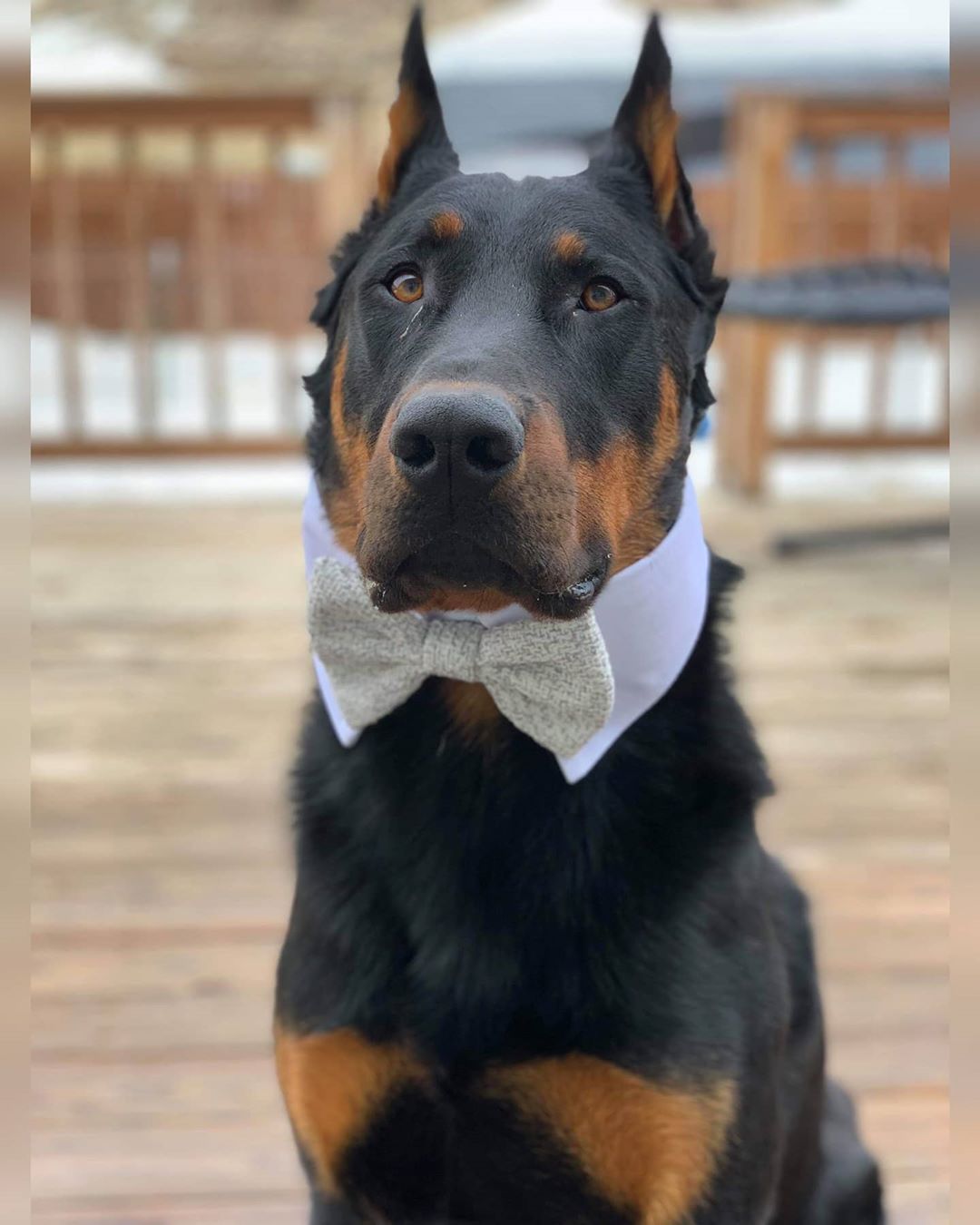
Beauceron is a dog with an even and balanced type of psyche. It is a highly socialized creature that gets along well with congeners and other animals. The French Shepherd, which may seem strange for such an independent dog, is in dire need of manifestations of mutual love and affection on the part of a person.
Genetically, the presence in the character of such traits as observation and attention to detail is inherent. Beauceron is smart, quick-witted, they work great in a team.
The character is complicated by the desire of the “boss” to dominate, which is especially noticeable in males. The desire to control is expressed quite vividly and is often directed not only at other animals in the house but also at family members. Many owners joke that the Beauceron, as a true herding dog, considers those around him to be helpless sheep, for which he is entirely responsible. Maybe it really is. A willingness to protect the weak is the hallmark of the Berger de Beauce. That is why even small children can be safely entrusted to them.
Many are surprised by the habit of this dog slightly bite and pinch people by the legs. Such behavior does not pose any threat to human health, but it is because in this way the distant ancestors of today’s shepherd dogs managed herds, pointing them in the right direction of movement. This gesture is by no means aggression, but simply a manifestation of vigilance and concern for others.
Beauceron unquestioningly accepts the master’s authority and obeys him in everything. Don’t confuse this with servility and servility. To paraphrase the classic, we can say that the “boss” will serve, but never will. Building such a relationship with a dog is possible only through justice, respect, and love. It should be borne in mind that such love for the owner also has a negative side. Long-term separation is very difficult for these dogs and may even get sick.
Beauceron’s character is also strongly influenced by his lifestyle. A dog that does not have sufficient physical activity, the ability to throw out the accumulated energy, can soon become irritable, aggressive, or, conversely, indifferent to everything.
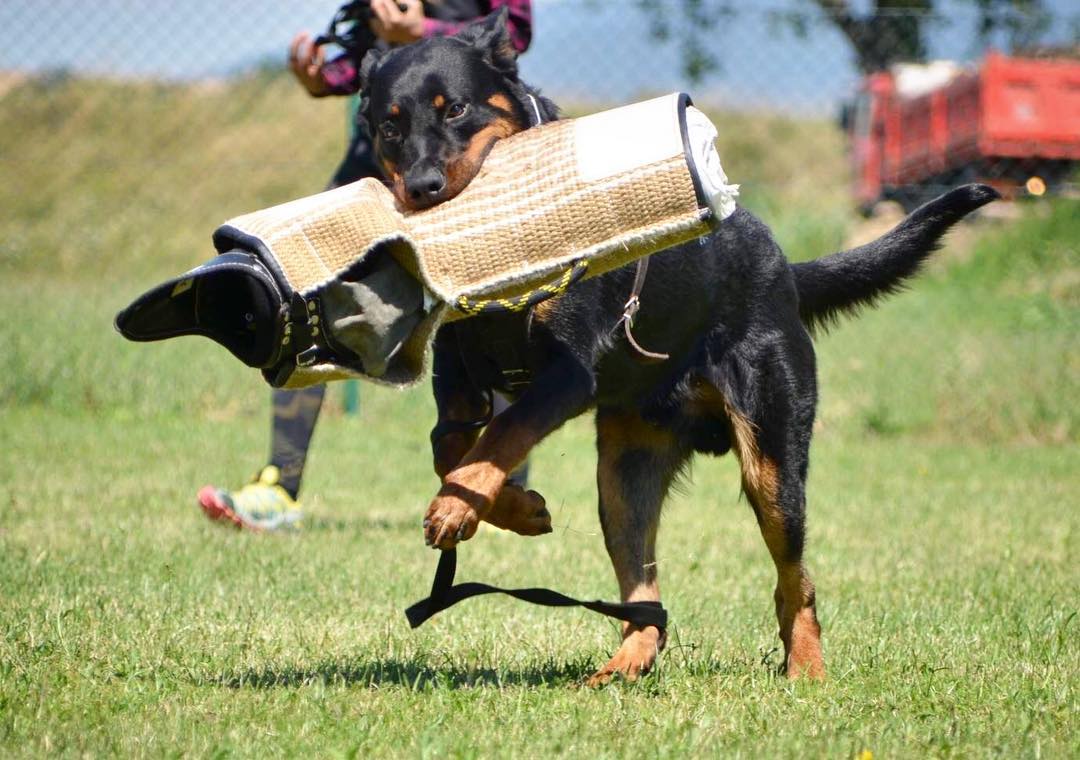
The upbringing of a Beauceron begins from the very first day of his appearance in the house. Considering that the dog grows up rather slowly (males – up to two or three years of age, females – a little faster), you should be prepared to keep the issues of upbringing and training the dog under constant control all this time.
The process begins with the fact that the baby must clearly learn several simple rules. The puppy is taught to the place, the regimen of food intake, the time of walks. “Boss” must understand the prohibition on begging, he should not be allowed to gnaw on shoes and spoil household items, even if he is still quite a toddler, and his tricks rather touch you than angry. To achieve the result, it will take some time and the patience of the owner. Remember that any form of violence or injustice against your dog can permanently ruin your relationship with the Beauceron. The owner himself must be engaged in raising the puppy – helping pets in this matter will not be the best solution. Firstly, the kid will simply get lost, whose requirements he should fulfill, and, secondly, with this technique, you will definitely not be able to become a real “leader” for the dog.
French Shepherds are very intelligent. You can start training them from an early age. Beauceron’s temperament is such that he does not accept routine and monotony. Training is best done playfully and not unnecessarily overload a young dog.
When starting training, take into account the personality traits of your pet and remember that success will come only if you can establish contact and achieve complete mutual understanding. Train your dog consistently – from simple commands to more complex ones. Don’t try to get all sorts of tricks performed right away. If any difficulties arise, it is better to take a step back than forcibly trying to force the animal to execute this or that command. And this is not only about physical punishment, which is absolutely unacceptable. Moral pressure can also seriously upset the balance of your relationship, as the Beauceron is a very empathetic dog.
It is better to train the “boss” in quiet places, away from the hustle and bustle. So your pupil will not be distracted once again and will quickly achieve the desired result. You need to reward your dog for success with treats. To make this method more effective, teach your pet either before feeding, or 4-5 hours after it. A well-fed animal is reluctant to work and simply does not see much interest in earning tidbits.
Having managed to properly educate and train the Beauceron, you will get an amazing dog – a devoted friend and reliable protector.
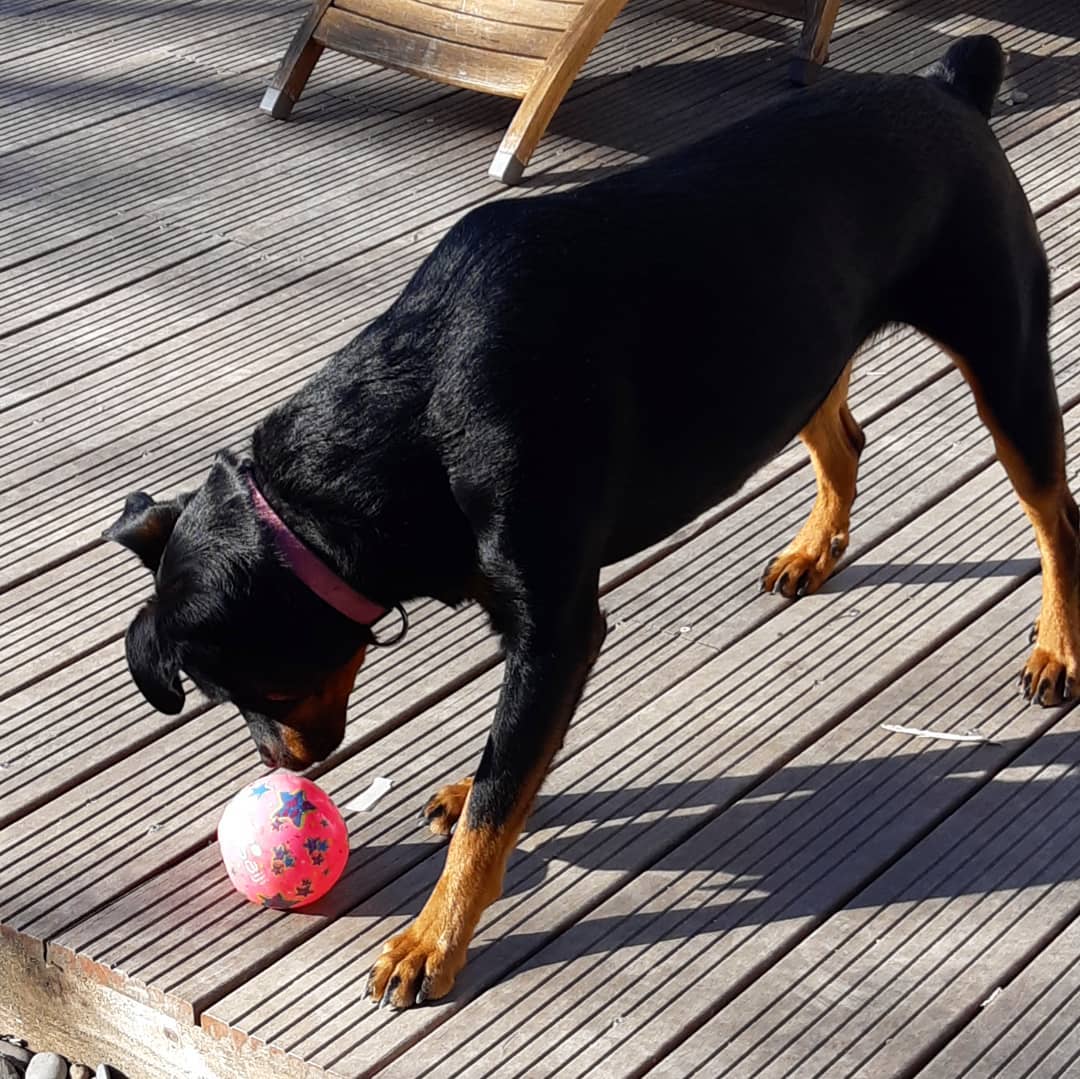
Beauceron is an unpretentious dog, and its content is reduced to compliance with several simple requirements.
Haircare consists of periodically brushing with special combs. During the shedding period, it is necessary to remove the fallen hair daily, although it should be noted that dogs of this breed rarely shed.
It is enough to bathe the Beauceron once a month or as needed if the dog is dirty. For water procedures, special zoo shampoos are used. Beauceron’s claws are trimmed as necessary if they become too long and begin to cause inconvenience to the dog. The eyes and ears should be kept clean by removing any excess dirt with cotton swabs.
It seems most reasonable to have an animal of this breed for the owners of country houses. As a habitat, you can equip an aviary of the desired size, but you should not keep the beacons on a chain. If this cannot be avoided in certain situations, try to shorten the time of restriction of freedom as much as possible. When kept in an apartment, you cannot do without long systematic walks with good physical activity.
There are two ways to organize your dog’s nutrition – use ready-made dry food or natural products.
Ready-made feeds seem to be preferable to many. This is both time saving for the owner and a guarantee that the animal will receive everything necessary for development and health with food, but only if specialized high-quality formulations are used.
If you are making a natural Beauceron diet, remember:
- from meat products, it is better to opt for veal or chicken. Pork is too fat and not recommended for these dogs;
- milk for adult dogs should not be given, low-fat cottage cheese and cheese will bring much more benefit;
- cereal porridge in the diet is simply necessary;
- fruits and vegetables are also a must on the menu.
Beauceron, like most dogs, is a potential sweet tooth, but here you have to be strict. Cakes, sweets, chocolate are not for your friend. Moreover, pet shops offer as an alternative a large assortment of dog treats that can and should be successfully used both during training and simply to pamper your pet.
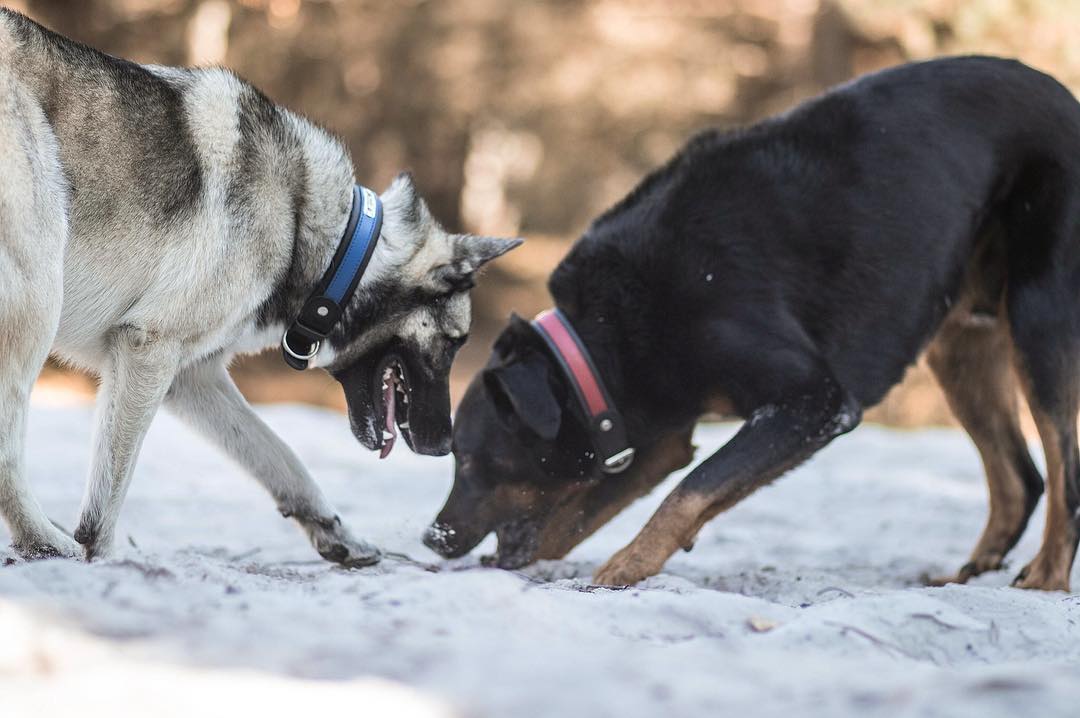
Dogs of this breed are distinguished by good health. With proper care, Beauceron is ill infrequently and up to 10-12 years of age, and sometimes longer, retains good spirits and performance.
French Shepherds are not susceptible to specific hereditary diseases. Even dysplasia of the hip or elbow joint, which is quite common in large dogs, is quite rare for Beauceron. The percentage of diagnosis of gastric volvulus in these animals is very small, but such cases do occur. Most often, males are affected by the age of 5 years. If your pet suddenly begins to show characteristic symptoms – the urge to vomit, bloating, severe pain in this area, a sharp deterioration in general condition – immediately go to the clinic. Without urgent surgical intervention, the animal may die.
Sometimes the representatives of this breed have heart problems.
Earlier, no exceptions were made in the ears of the Beauceron, and pathogenic microflora did not develop in the open “ventilated” shell. Today, in many countries, it is forbidden to subject dogs to such surgical intervention. Harmful microorganisms in the uncropped ear get much more comfortable conditions for development, which can lead to the development of otitis media of various nature. It is better to entrust the treatment of such a disease to a specialist.
Compliance with vaccination schedules, deworming, and proper nutrition are important in keeping your pet healthy.

How to choose a puppy?
Those wishing to have a Beauceron should know that in our country it is a very rare breed, so it is impossible to buy an animal via the Internet or on the poultry market. Any such offer is 100% fraudulent.
A guarantee of blood purity can only be given to you in a seriously reputable nursery that specializes in breeding beacons.
You can sometimes wait for a French Shepherd puppy for a long time. If you have such an opportunity, use this period to get to know the breeders, see the parents of the future baby, evaluate their temperament, intelligence, character, and study the pedigree.
A Beauceron puppy is usually picked at around seven weeks of age. By this time, in a specialized nursery, the baby will undergo specially designed testing. According to its results, experts give predictive assumptions about what kind of character a dog may have and how its working qualities will manifest themselves. When buying a French Shepherd, ask about the test results of your chosen one.
If the baby did not pass the test, choose the most lively and playful one.
In addition, pay attention to the following nuances.
- Beauceron should be cheerful, cheerful, moderately active, and curious.
- By the age of 7-8 weeks, the puppy is already quite large, with a shiny glossy coat.
- The eyes and ears must be clean and free of unpleasant odors.
- The paws of a healthy puppy are thick, with strong bones, on the hind legs there are two dewclaws.
- The darker the color of the Beauceron iris, the better. In marbled puppies, the eyes can be of different colors.
- The color of the tan marks is allowed light with yellowness (it may darken with age), but the fur areas should be initially darker with a reddish tint.

